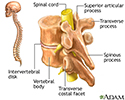Spinal tumor
Tumor - spinal cord
A spinal tumor is a growth of cells (mass) in or surrounding the spinal cord.
Causes
Any type of tumor may occur in the spine, including:
-
Leukemia
(blood cancer that starts in the white cells in the bone marrow)
Leukemia
Leukemia is a type of blood cancer that begins in the bone marrow. Bone marrow is the soft tissue in the center of the bones, where blood cells are ...
 ImageRead Article Now Book Mark Article
ImageRead Article Now Book Mark Article -
Lymphoma
(cancer of the lymph tissue)
Lymphoma
Hodgkin lymphoma is a cancer of lymph tissue. Lymph tissue is found in the lymph nodes, spleen, liver, bone marrow, and other sites.
 ImageRead Article Now Book Mark Article
ImageRead Article Now Book Mark Article -
Myeloma
(blood cancer that starts in the plasma cells of the bone marrow)
Myeloma
Multiple myeloma is a blood cancer that starts in the plasma cells in the bone marrow. Bone marrow is the soft, spongy tissue found inside most bone...
 ImageRead Article Now Book Mark Article
ImageRead Article Now Book Mark Article
A small number of spinal tumors occur in the nerves of the spinal cord itself.
Tumors that start in spinal tissue are called primary spinal tumors. Tumors that spread to the spine from some other place (metastasize) are called secondary spinal tumors. Tumors may spread to the spine from the breast, prostate, lung, and other areas.
The cause of primary spinal tumors is unknown. Some primary spinal tumors occur with certain inherited gene mutations.
Spinal tumors can occur:
- Inside the spinal cord (intramedullary)
- In the membranes (meninges) covering the spinal cord (extramedullary - intradural)
- Between the meninges and bones of the spine (extradural)
Or, tumors may extend from other locations. Most spinal tumors are extradural.
As it grows, the tumor can affect the:
- Blood vessels
- Bones of the spine
- Meninges
- Nerve roots
- Spinal cord cells
The tumor may press on the spinal cord or nerve roots, causing damage. With time, the damage may become permanent.
Symptoms
The symptoms depend on the location, type of tumor, and your general health. Tumors that have spread to the spine from another site (metastatic tumors) often progress quickly. Primary tumors often progress slowly over weeks to years.
Tumors in the spinal cord usually cause symptoms, sometimes over large portions of the body. Tumors outside the spinal cord may grow for a long time before causing nerve damage.
Symptoms may include:
-
Abnormal sensations
or loss of sensation, especially in the legs (may be in the knee or ankle, with or without shooting pain down the leg)
Abnormal sensations
Numbness and tingling are abnormal sensations that can occur anywhere in your body, but they are often felt in your fingers, hands, feet, arms, or le...
 ImageRead Article Now Book Mark Article
ImageRead Article Now Book Mark Article - Back pain that gets worse over time, is often in the middle or lower back, is usually severe and not relieved by pain medicine, gets worse when lying down or straining (such as during a cough or sneeze), and may extend to the hips or legs
- Cold sensation of the legs, cool fingers or hands, or coolness of other areas
-
Loss of bowel control
Loss of bowel control
Bowel incontinence is the loss of bowel control, causing you to pass stool unexpectedly. This can range from sometimes leaking a small amount of sto...
 ImageRead Article Now Book Mark Article
ImageRead Article Now Book Mark Article -
Bladder leakage
,
muscle contractions,
twitches, or spasms (fasciculations)
Bladder leakage
Stress incontinence occurs when your bladder leaks urine during physical activity or exertion. It may happen when you cough, lift something heavy, c...
 ImageRead Article Now Book Mark Article
ImageRead Article Now Book Mark ArticleMuscle contractions,
Muscle cramps are when a muscle gets tight (contracts) without you trying to tighten it, and it does not relax. Cramps may involve all or part of on...
 ImageRead Article Now Book Mark Article
ImageRead Article Now Book Mark Article -
Muscle function loss
Muscle function loss
Muscle function loss is when a muscle does not work or move normally. The medical term for complete loss of muscle function is paralysis.
Read Article Now Book Mark Article -
Muscle weakness
(decreased muscle strength) in the legs that causes falls, makes walking difficult, and may get worse (progressive)
Muscle weakness
Weakness is reduced strength in one or more muscles.
Read Article Now Book Mark Article
Exams and Tests
A nervous system (neurological) examination may help pinpoint the location of the tumor. The health care provider may also find the following during an exam:
- Abnormal reflexes
- Increased muscle tone
- Loss of pain and temperature sensation
- Muscle weakness
- Tenderness in the spine
These tests may confirm spinal tumor:
-
Cerebrospinal fluid (
CSF
) examination
CSF
A CSF cell count is a test to measure the number of red and white blood cells that are in cerebrospinal fluid (CSF). CSF is a clear fluid that in th...
 ImageRead Article Now Book Mark Article
ImageRead Article Now Book Mark Article -
Cytology
(cell studies) of CSF
Cytology
Cytologic evaluation is the analysis of cells from the body under a microscope. This is done to determine what the cells look like, and how they for...
 ImageRead Article Now Book Mark Article
ImageRead Article Now Book Mark Article -
Myelogram
Myelogram
A lumbosacral spine x-ray is a picture of the small bones (vertebrae) in the lower part of the spine. This area includes the lumbar region and the s...
 ImageRead Article Now Book Mark Article
ImageRead Article Now Book Mark Article -
Spinal CT
Spinal CT
A lumbosacral spine CT is a computed tomography scan of the lower spine and surrounding tissues.
 ImageRead Article Now Book Mark Article
ImageRead Article Now Book Mark Article - Spine MRI
-
Spine x-ray
Spine x-ray
A thoracic spine x-ray is an x-ray of the twelve chest (thoracic) bones (vertebrae). The vertebrae are separated by flat pads of cartilage called di...
 ImageRead Article Now Book Mark Article
ImageRead Article Now Book Mark Article
Treatment
The goal of treatment is to reduce or prevent nerve damage caused by pressure on (compression of) the spinal cord.
Treatment should be given quickly. The more quickly symptoms develop, the sooner treatment is needed to prevent permanent injury. Any new or unexplained back pain in a patient with cancer should be thoroughly investigated.
Treatments include:
- Corticosteroids (dexamethasone) may be given to reduce inflammation and swelling around the spinal cord.
- Emergency surgery may be needed to relieve compression on the spinal cord. Some tumors can be completely removed. In other cases, part of the tumor may be removed to relieve pressure on the spinal cord.
-
Radiation therapy
may be used with, or instead of, surgery.
Radiation therapy
Radiation therapy uses high-powered x-rays, particles, or radioactive seeds to kill cancer cells.
 ImageRead Article Now Book Mark Article
ImageRead Article Now Book Mark Article -
Chemotherapy
has not been proven effective against most primary spinal tumors, but it may be recommended in some cases, depending on the type of tumor.
Chemotherapy
The term chemotherapy is used to describe cancer-killing drugs. Chemotherapy may be used to:Cure the cancerShrink the cancerPrevent the cancer from ...
 ImageRead Article Now Book Mark Article
ImageRead Article Now Book Mark Article - Physical therapy may be needed to improve muscle strength and the ability to function independently.
Support Groups
You can ease the stress of illness by joining a support group whose members share common experiences and problems.
Outlook (Prognosis)
The outcome varies depending on the tumor. Early diagnosis and treatment usually leads to a better outcome.
Nerve damage often continues, even after surgery. Although some amount of permanent disability is likely, early treatment may delay major disability and death.
When to Contact a Medical Professional
Call your provider if you have a history of cancer and develop severe back pain that is sudden or gets worse.
Go to the emergency room or call the local emergency number (such as 911) if you develop new symptoms, or your symptoms get worse during the treatment of a spinal tumor.
References
Deangelis LM. Tumors of the central nervous system. In: Goldman L, Schafer AI, eds. Goldman-Cecil Medicine . 25th ed. Philadelphia, PA: Elsevier Saunders; 2016:chap 189.
Moron FE, Delumpa A, Szklaruk J. Spinal tumors. In: Haaga JR, Boll DT, eds. CT and MRI of the Whole Body . 6th ed. Philadelphia, PA: Elsevier; 2017:chap 30.
Sciubba DM, Baaj AA, Gokaslan ZL. Spinal cord compression. In: Niederhuber JE, Armitage JO, Doroshow JH, Kastan MB, Tepper JE, eds. Abeloff's Clinical Oncology . 5th ed. Philadelphia, PA: Elsevier Churchill Livingstone; 2014:chap 49.
-
Vertebrae - illustration
The vertebral column is made up of 26 bones that provide axial support to the trunk. The vertebral column provides protection to the spinal cord, which runs through its central cavity. Between each vertebra is an intervertebral disk, which acts as a shock absorber.
Vertebrae
illustration
-
Spinal tumor - illustration
This photograph shows the presence of tumor within the vertebrae. The tumor is dense white against the red interior of the bone.
Spinal tumor
illustration
-
Vertebrae - illustration
The vertebral column is made up of 26 bones that provide axial support to the trunk. The vertebral column provides protection to the spinal cord, which runs through its central cavity. Between each vertebra is an intervertebral disk, which acts as a shock absorber.
Vertebrae
illustration
-
Spinal tumor - illustration
This photograph shows the presence of tumor within the vertebrae. The tumor is dense white against the red interior of the bone.
Spinal tumor
illustration
Review Date: 8/15/2016
Reviewed By: Todd Gersten, MD, Hematology/Oncology, Florida Cancer Specialists & Research Institute, Wellington, FL. Review provided by VeriMed Healthcare Network. Also reviewed by David Zieve, MD, MHA, Isla Ogilvie, PhD, and the A.D.A.M. Editorial team.


